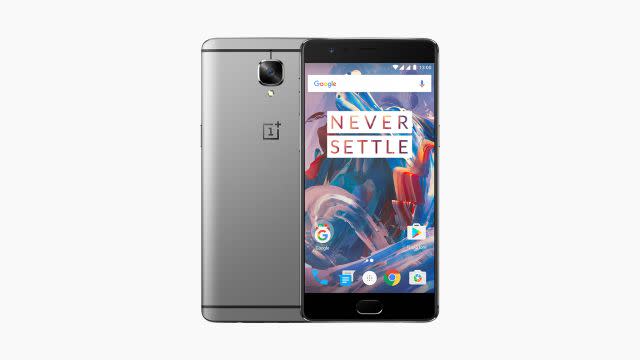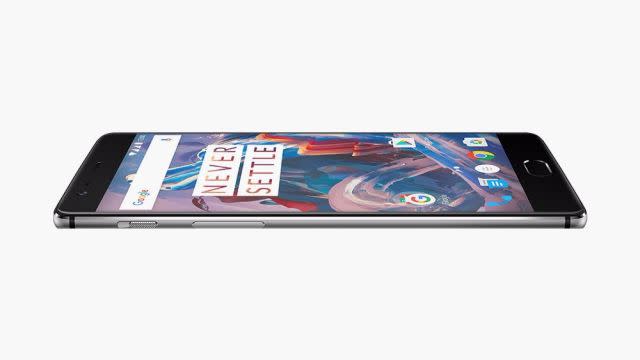The OnePlus 3 proves there’s no reason why smartphones should cost so much

It’s becoming less and less apparent why high-end smartphones need to cost so much.
A brand new, unlocked, iPhone 6S starts at $649, and a Samsung Galaxy S7 starts at $700. They’re both great phones, but other than brand names, it’s not entirely clear what you’re getting for your money, at least when compared to what else is on the market. Much like the new Sprint commercials that question why it’s not better to pay considerably less for about the same level of service, it’s worth questioning if you need to shell out so much for a new smartphone.
The latest smartphone from upstart Chinese manufacturer OnePlus seems to be an answer to that question: The OnePlus 3 is pretty much on par with every other manufacturers’ top-of-the-line devices, but at a little more than half the cost.
I spent a week testing the phone and found it to be one of the best phones I’ve used in a while.
What’s good
It’s a OnePlus. I said the same thing when I reviewed the OnePlus X and the OnePlus 2—this company makes solid phones with out a lot of bloat, and the OnePlus 3 is really no exception. All the features I liked in earlier models—such as being able to tap the screen to wake up the phone, and the three-way notification dial—are in the OnePlus 3. It also happens to be a powerful, more capable phone than its predecessors.
It’s cheap. In the US, the OnePlus 3 starts at $399, and it will cost €399 in Europe, £309 in the UK, ₹27,999 in India.
The camera. While some have taken issue with the cameras on past OnePlus phones, there’s little to complain about here. The OnePlus 3 comes equipped with a 16-megapixel rear camera and an 8-megapixel front-facing camera for extra sharp selfies. The rear camera also has a mechanical and digital image stabilizer to account for a photographer’s shaky hands. The camera also has a manual mode, which allows shutterbugs to fine-tune their photos, and adjust focus, white balance, ISO, and shutter speed as they see fit. (Disclosure: I am not a very good photographer, so I couldn’t replicate the sharp-focus shallow depth of field photos that OnePlus showed off in its press materials, but apparently it’s possible.)
Nice display. The high-definition 1080p AMOLED display looks great. It’s not quite as high-res as the Samsung Galaxy S7 Edge I tested out earlier this year, but it’s pretty much identical to the display on the iPhone 6S Plus I usually use, which is still no slouch.
Lots of space. The OnePlus 3 comes with 64 GB of storage space out of the box. That’s four times what the base iPhone model currently ships with, and double the Samsung Galaxy S7. Snap photos and videos to your heart’s content.
It’s fast. The phone ships with 6 GB of RAM—triple what the iPhone 6S Plus ships with—and has a snappy, top-of-the-line 2.2 Ghz Snapdragon processor on board that means even the most processor-heavy apps and games should run smoothly on the OnePlus 3.
No junk software. One of the biggest complaints levied against many other Android flagship phones on the market is the amount of “bloatware”—unnecessary or gimmicky software—that the manufacturers include in their devices that can’t easily be removed or uninstalled. Samsung has been particularly egregious with this in the past. OnePlus runs a customized version of Android that it calls OxygenOS that’s pretty much the clean, stock Android software that Google intended it to be, with a few minor upgrades.
Speedy charging. The OnePlus 3’s “dash” charging system allows the phone to charge to 60% capacity in just 30 mins, meaning you shouldn’t ever be stranded with a dead phone—if you remember to bring your charger with you. You can even keep charging while doing processor heavy tasks, like playing games, unlike many other phones on the market.
No invites. In the past, OnePlus has tried to create artificial demand by requiring customers to get invites from other OnePlus owners to buy a phone themselves, as well as other logistical hoops to jump through. The company said it’s done away with this for the OnePlus 3, which you can order now from the company’s website, without any hassle.
Two SIM card slots. It’s not the only phone to offer this feature, but if you’re a world traveler, or prefer different calling plans on multiple cellphone carriers, the OnePlus can accommodate your SIM needs.

What’s not so good
The battery life. It’s not terrible, but I was going from an iPhone 6S Plus, where I rarely run out of charge in a regular day’s use, to the OnePlus 3, where I’m in the red by the end of the evening. But with the dash charging, your phone will never be dead for long, so it’s not a massive issue.
It gets hot. Many smartphones get warm in hot weather or when they’re used extensively, and the OnePlus 3 was no exception, though it did seem to feel warmer in my pocket even when I hadn’t been using it for a while.
The design. There’s nothing particularly bad about the OnePlus 3’s design—although the edges of the phone could’ve benefitted from being a little more rounded—there’s also nothing particularly amazing about it either. The rear of the phone looks nearly identical to the HTC One M9, and with the oblong home button, the front looks pretty similar to Samsung’s current flagship phones. The OnePlus 3 is kind of like a Lexus—you can tell it looks nice, but you also feel like you’ve seen its design before in other fancy machines.
The cases. For some reason, OnePlus felt the need to send me five cases to test the phone with. I used the one that looks like it’s made of carbon fiber, although I don’t think it is. None of the stock cases feel particularly sturdy, and I’m not sure how well they’d protect the phone from a drop, as they’re all quite thin. They’re also $20 a pop.
The VR headset. The review unit OnePlus sent me included its new Loop VR headset. It looks a lot like Samsung’s Gear VR headset, but without any of its features. Samsung’s headset needs to be charged, and has built-in head-tracking technology to help improve the VR experience. The Loop VR has none of this: It’s just a plastic box that sits heavily on your face. When testing it out with a few VR apps, I found it to be less enjoyable and harder to watch on than a simple Google Cardboard box. According to OnePlus, the headset was just an add-on for the review unit, and a representative told Quartz that it gave away 30,000 units available ahead of the OnePlus 3 launch, but wasn’t immediately available to explain whether it will be going on sale to consumers again any time soon.
Should you get one?
If you’re looking to get a new Android phone right now, it’s hard not to recommend the OnePlus 3. Minor gripes aside, it has the same build quality and abilities of just about any major company’s flagship phone. Why spend about $800 on a brand new Samsung Galaxy S7 Edge (which to be fair, is a great phone) when you can spend $400 on this?

Sign up for the Quartz Daily Brief, our free daily newsletter with the world’s most important and interesting news.
More stories from Quartz:

